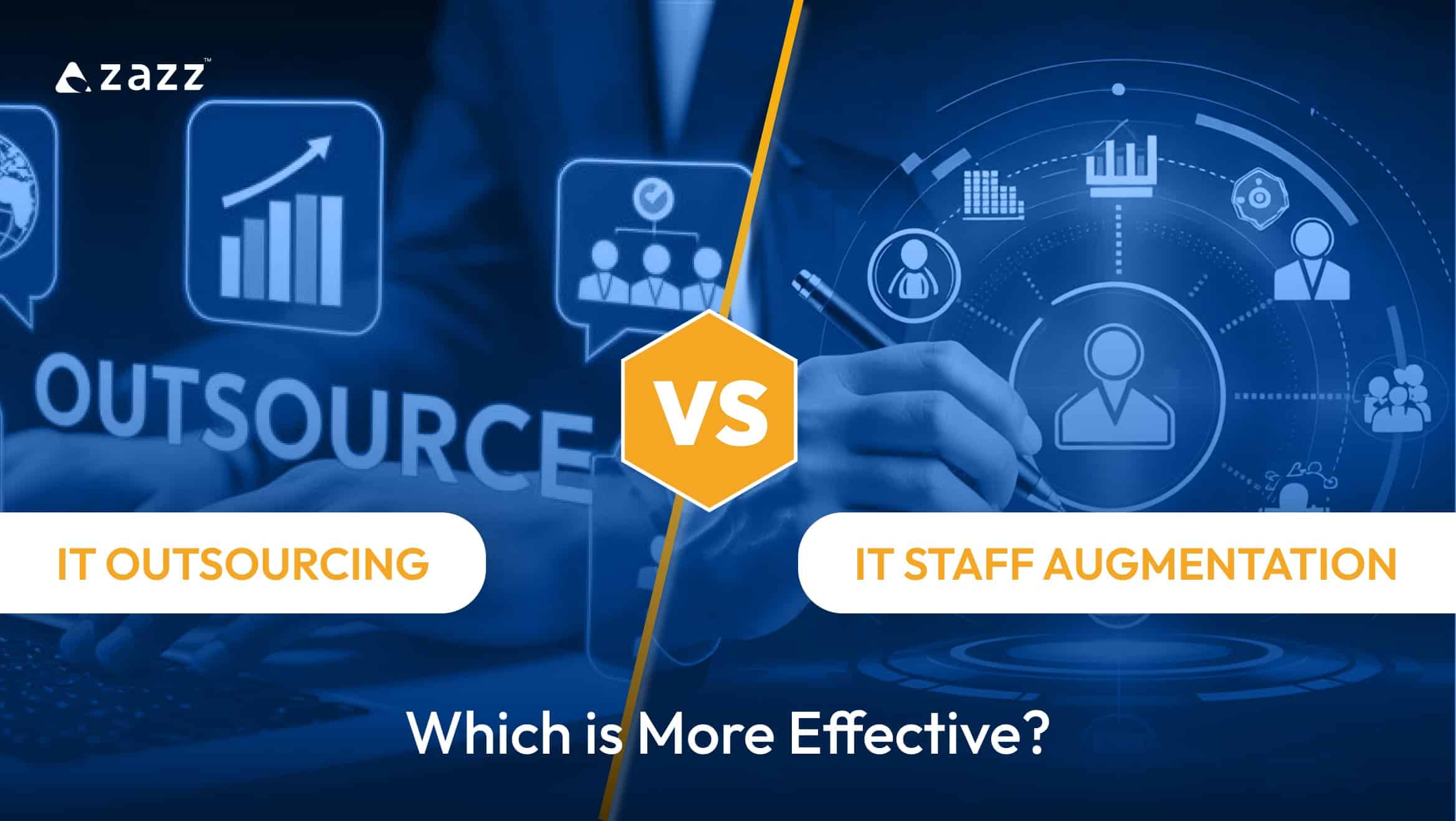
Table of Content 1.What is IT Project Outsourcing?
2.What is IT Staff Augmentation?
3.The Key Difference Between IT Staff Augmentation vs. IT Outsourcing
4.Which is better for you?
A complex project or a growing company may require new skills that the existing team lacks. This results in a gap between what the internal team is able to do and what the project needs. Many IT projects experience fluctuations in demand. One month, the workload may be manageable, and the next, there’s an urgent need for more resources. Without flexible staffing options, this can lead to project delays and overburdening the existing team.
There are two popular models for meeting flexible staffing needs: Staff augmentation and outsourcing. Now, as you compare IT staff augmentation vs IT outsourcing services, you can prevent inefficiencies, control costs, and provide new openings for your business to take off.
Here, you’ll learn about the drawbacks and benefits of staff augmentation and outsourcing. We’ll also discuss when each of them is most suitable for your IT projects.
What is IT Project Outsourcing?
When a company contracts out IT project handling (including part or all of it), this service is known as IT project outsourcing. Management decides to outsource some or all of the management duties of an IT project to a third party.
The whole project must be planned, organized and implemented by the third party in accordance with agreed objectives, targets and deadlines.
What is IT Staff Augmentation?
Staff augmentation refers to a model that brings in outside IT experts temporarily to work with your in-house team. This method is used to fill skill gaps, expand system size for particular projects, and deal with temporary limitations on resources.
Unlike outsourcing, which typically results in a third-party company managing and carrying out an entire project on its own, staff augmentation is the integration of external personnel as part of your team. Here, you have full control over where the project is heading and how it will be handled.
Related reading: IT Staff Augmentation Process, Pros and Cons
The Key Difference Between IT Staff Augmentation vs. IT Outsourcing

staff augmentation vs project outsourcing – each strategy addresses different operational needs. Understanding the differences between these two models is key to choosing the right approach.
| Comparison Factor | IT Staff Augmentation | IT Outsourcing |
| Project Control and Management | The client retains control of management. | Full control and management transferred to the vendor. |
| Team Integration | Better integration with existing teams. | Handled by external teams, integration may be challenging. |
| Cost Structure | Typically hourly/daily rates can be flexible but costly long-term. | Often a fixed-price model, predictable costs for projects. |
| Flexibility & Scalability | Greater flexibility to scale resources as needed. | Less flexible to adjustments after project scope is defined. |
| Knowledge Retention | Better knowledge retention within the client organization. | Knowledge often retained by the vendor can be a disadvantage. |
| Skill Specialization | Fills specific skill gaps in existing teams. | Access to specialized skills for projects. |
| Project Duration | Often better for short-term projects. | Generally suited for longer-term projects. |
| Communication and Collaboration | Direct and frequent communication with in-house teams. | More formal communication channels with external teams. |
| Risk Management | More control in-house, but needs effective resource management. | Transfers some project risks to the vendor. |
Every approach has its advantages and limitations, and its suitability depends on various factors such as project requirements, control preferences, and resource availability.
Related reading: Guide on What is IT Staff Augmentation? Types, Benefits
Overhead Costs
When comparing project outsourcing vs IT staff augmentation for overhead costs, staff augmentation involves the temporary addition of staff, which includes their salaries, benefits, and any associated training or onboarding expenses. Staff augmentation usually operates at an hourly or daily rate and can be adjusted according to the project’s development process. However, while this model avoids the long-term commitments of permanent hires, it can become costly if extended over a long period.
Project outsourcing usually uses a fixed-price model that is based in advance on the project’s work. This provides certainty and puts all major and minor costs on a management basis which avoids any need to keep revising them. However, in certain cases, outsourcing may bring variable expenses when additional resources or adjustments are necessary during different stages of the project.
Primary Duties
The main idea of IT staff augmentation is to incorporate staff from external organizations as part of your existing team so that they can fill skill gaps or relieve specific projects’ strains. Moreover, in this method, staff is your direct responsibility, they work on the current projects without any disturbance. Such a model ensures that your in-house team can still maintain full control over the process and timeline.
In contrast, IT project outsourcing transfers the whole operation of project management and implementation to an external company. In this model, the outsourced company plans, supervises, and delivers the whole project using a Gantt chart software. This method can ensure that all aspects of the project are handled independently by third parties and thus relieve your team members from some of their work burdens.
Working Location
In a staff augmentation model, Augmented staff normally work within your organization’s IT department, but may occasionally work remotely. It encourages more interaction with your teammates to enhance the team’s coordination and cooperation.
IT business outsourcing of projects also means that the outsourcing team is most of the time geographically distant and may be located in a different country. This opens up a larger pool of talent and may also be cheaper in different parts of the world.
Related reading: Top 10 IT Staff Augmentation Best Practices
Onboarding
Onboarding in staff augmentation vs software outsourcing – each model integrates into your organization differently.
For IT staff augmentation, onboarding means getting external professionals onto your existing team as quickly as possible to carry out particular projects. This includes procedures such as a needs analysis to pinpoint the skills required, corporate culture and work methods, and provision of tools and systems needed by everyone in the team.
Then again, IT outsourcing onboarding is managed by a third party that begins with gathering essential data, performing an IT audit, and training their employees to understand your project requirements. This process includes preparing their staff to handle your systems and ensuring they have all of the necessary resources and knowledge to conduct the project autonomously.
Project Management
Project management in IT staff augmentation remains the responsibility of your internal team. Employees work directly for you to fulfill objectives related to the project and let you have control over the project. This brings conformity within your organization hence ensuring that it meets all its internal processes and standards. However, it poses a management challenge to the existing human resources since they shall be expected to coordinate, plan, schedule, and supervise efforts.
Quite often, IT project outsourcing implies that the outsourcing provider assumes full responsibility for the project: planning, carrying out the project, and delivering it. This takes the burden of project management from your internal team freeing them up to work on other strategic projects. You will surrender several decision-making responsibilities to the provider, and, thus, receive a more efficient project implementation.
Related reading: Staff Augmentation Pricing model : A complete guide
Which is better for you?
In comparison between staff augmentation vs IT outsourcing, the most difficult decision is when to use each model. Both have their advantages and are used in different situations.
Staff augmentation is good when you need temporary, on-demand talent to supplement the team you already have. That means it lets you maintain full control over a project but still has all kinds of options for adding workers. At the same time, this model also means reducing long-term hiring and infrastructure costs while allowing you to scale your team for short-term project demands.
Outsourcing, however, is superior when you need to hand over a whole project that an outside company does quickly. It gives you a broad pool of talent, a great asset for tasks demanding large-scale or complex work with specialized expertise. It also lets the company’s internal team concentrate on activities that generate value.
The priority, irrespective of IT staff augmentation vs outsourcing, must be quality. Zazz is aware of the complexities involved and offers solutions to help you navigate them effectively.
Still unsure? Contact us today so we can support your IT initiatives.
Frequently Asked Questions
Staff augmentation is a flexible outsourcing strategy that allows organizations to hire external personnel to fill specific skill gaps or meet temporary staffing needs. This approach enables companies to access specialized talent quickly without the long-term commitment of permanent hires.
The benefits of staff augmentation include increased flexibility, faster access to skilled professionals, reduced hiring costs, and the ability to scale teams up or down based on project demands. It also allows organizations to focus on their core competencies while leveraging external expertise for specific tasks.
Staff augmentation involves hiring external talent to work alongside existing teams, typically on-site, while traditional outsourcing often entails transferring entire projects or functions to a third-party provider. With staff augmentation, organizations retain control over the project and can integrate augmented staff into their existing workflows.
Staff augmentation can be used for a wide range of roles across various industries, including IT professionals (developers, testers, data analysts), marketing specialists, project managers, engineers, and administrative support. Organizations can find experts for both short-term projects and long-term needs.
Companies can ensure quality by thoroughly vetting candidates through rigorous screening processes, including interviews, skills assessments, and reference checks. Collaborating with reputable staff augmentation firms can also help ensure that the augmented personnel meet the necessary qualifications and expertise.
Organizations should consider their specific needs, budget constraints, the duration of the project, and the required skills. Additionally, it’s essential to establish clear communication protocols, define roles and responsibilities, and integrate augmented staff into the company culture to maximize collaboration and productivity.











